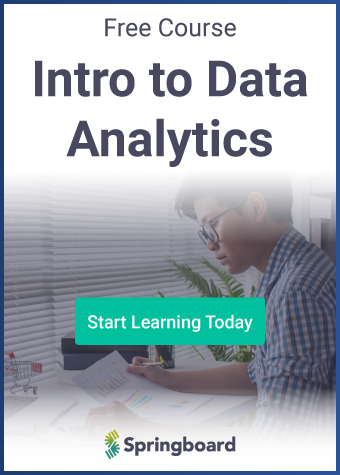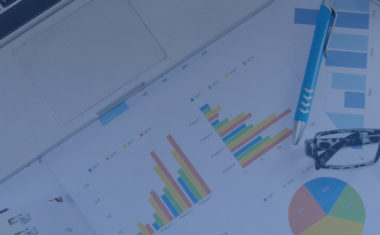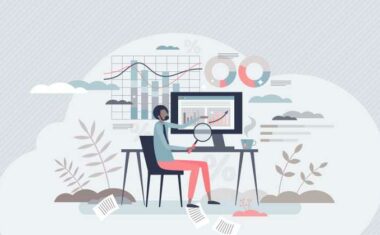The Definitive List of Data Analytics Tools

In this article

Data analysts take raw input and make magic happen. This “magic” process of making data more palatable (or more importantly, useful) is called the data pipeline. To get there, you need the right data analytics tools, but what are the right tools?
We’ve curated a list of useful software—an extended data analytics stack—that data analysts should master to efficiently move data through the pipeline—from raw data to clear insights. Some tools fit neatly into one section of the pipeline, such as data collection and mining. Others bleed into other parts of the pipeline. And others do it all, so they don’t really fit into any one box. Nonetheless, all of them will help you do your job better.
Let’s roll.
Data Collection and Mining
Before you can conduct data analysis, you need data—more data than you think you need. Sometimes you can find data sets that have done some of the work for you, and you’ll want to mine those data sets for patterns.
Here are some useful tools that can mine data.
KNIME
KNIME is an open-source solution that has over 1,000 modules, several hundred useable demos, which covers all the data analytics functionality, and the largest repository of algorithms of any data analytics tool. It’s great for mining data, but it has many other useful features as well.
Learn more: Check out this video overview of the KNIME Analytics Platform.
RapidMiner
RapidMiner is an open-source platform based on visual programming. Its environment is best for machine learning and data mining experiments. It makes it possible to create analytical workflows in a short space of time. Better yet, RapidMiner is an entire data analytics stack in a single environment, allowing everything from data prep and machine learning to model validation and deployment. That being said, as the name suggests, RapidMiner does best for data mining-specific tasks.
Learn more: RapidMiner has a library of resources here.
Just as often as you must wrangle data you must collect data yourself. Not all of these tools will work all of the time. That’s because there are as many ways to collect data as there are data types (surveys, interviews, research, etc.).
For deciding this, it might help to think of data as an answer to a particular question—an answer you’ve got to translate. Say you want to know the answer to the question, “How are our customers using our products?” Face-to-face interviews with customers could work, but it would probably be more time consuming than you can afford. A well-designed survey would probably do the trick.
Here are a couple of tools for collecting new data.
Typeform
Data analysts primarily use Typeform as a survey form tool. That’s where it shines. It allows you to create custom forms to collect data. It integrates with Google Sheets and MailChimp and provides quick insights to make your job easier.
Learn more: These posts will take you through the survey creation and analysis process.
Heap
Sometimes collecting data is less direct than a survey. Heap allows you to collect behavioral data on customers by tracking events such as clicks, taps, changes, swipes, mouseovers, and much more. Along with data capture, it also provides insights into understanding customer behavior.
Learn more: This Q&A will introduce you to what Heap can do.
Get To Know Other Data Analytics Students
Sylwia Padiasek
Senior Research Analyst at Gro Intelligence
Jon Shepard
VP Of AI Research Strategy And Execution at J.P. Morgan
Gilles Ngomeni
Sales Analyst at Medline Industries
Data Storage
Once you’ve collected your data, you need a place to store it. Sometimes this is simple, and it’s handled with the collection software you use. Other times, especially when you’re working with large amounts of data, you need more robust solutions. More often than not, though, data will be stored in one of two types of databases: a centralized, relational database (such as MySQL) or a decentralized database (such as HDFS).
MySQL
You don’t necessarily need to know how to write your own SQL to navigate a SQL-based database server such as MySQL. MySQL houses data in centralized, structured tables and, although there’s no need for a user interface, you’ll almost certainly have one available to you, such as PHPMyAdmin. Through tools like PHPMyAdmin, you can directly edit tables, import new data, export data, write custom queries, and more.
Learn more: This tutorial tackles how to install MySQL, create databases and tables, and much more.
HDFS
HDFS stands for Hadoop Distributed File System. HDFS operates on the premise that hardware is bound to fail, so rather than housing data in a centralized location, where the system might have a single point of failure, it uses many hardware components to store data. HDFS allows users to work with terabytes of data and, although MySQL databases can also work with terabytes of data, many cite performance issues when relational databases scale to this size.
Learn more: Get started with the HDFS Architecture Guide.
Amazon Redshift
Amazon Redshift is a data warehouse service for relational databases. It’s primarily used for big data. Like Hadoop, it’s a distributed framework, meaning data is distributed on different nodes (servers) connected on a cluster.
Learn more: This resource library is a great place to start.
Data Analytics
Once you’ve got data collected and stored, you’ll need to put it through its paces to comprehend it. In other words, you’ll need tools to analyze it.
Apache Spark
Apache Spark is an open-source processing engine designed specifically for data analytics. A big advantage is that it can easily be integrated with the Hadoop ecosystem.
Spark is a useful tool for working on large data sets, particularly unstructured, static data. Furthermore, the addition of its own machine learning library makes Spark one of the best data analytics tools for machine learning tasks. It’s also equipped with GraphX, a specialist API for graph computations.
Learn more: Here’s a nice beginner’s guide to Apache Spark.
Microsoft Excel
What list would be complete without Excel, one of the most popular and useful tools, even among experts in more advanced systems. It has some advanced analytics options, such as time grouping and automatic relationship detection, as well as a plethora of visualization tools.
We could just as easily categorize Excel as a data visualization tool, but its popularity and use across all segments of the data pipeline is why we’ve chosen to spotlight its analytics capabilities.
Learn more: If you want to get more out of Excel, check out Springboard’s blog post: Excel Functions for Data Analysis.
Looker
Looker is an advanced analytics platform that can connect with relational databases like Google BigQuery or Amazon Redshift to create unique data models. You can refine these models to focus on key metrics and generate customized reports.
Looker is a user-friendly tool that works well for startups and large enterprises alike. Its collaboration features make it excellent for customized data reporting.
Learn more: The Looker website provides demo videos and other resources to show how Looker works.
Data Reporting and Visualization
Microsoft PowerPoint
You might think you escape Microsoft PowerPoint when you leave school. You probably never will, though. And you shouldn’t. While PowerPoint won’t do any heavy analytical lifting, it will help you communicate your insights.
PowerPoint is a presentation platform first and foremost, so you should leverage that to maximum effect when analyzing data.
Learn more: Check out these tips to create beautiful data science presentations.
Tableau
Tableau is one of the best data analytics tools on the market. As a user-friendly option, it’s quite easy for beginners to get to grips with, offering Excel advocates a big step up in terms of visualizations and sheer data handling capacity.
In addition to analyzing data, Tableau is very useful for visualizing data and creating interactive dashboards.
Learn more: This guide to Tableau explores a diverse range of advanced analytics techniques for business intelligence professionals.
Microsoft Power BI
If you want to focus on data visualization, you’ll struggle to find anything better than Microsoft Power BI. BI stands for business intelligence. Using this web-based tool, you can analyze trends in real-time from basically anywhere, which paves the way for greater agility in marketing.
This is a powerful tool for data analysts, as they can evaluate data and compile interactive visual reports in a matter of minutes.
Learn more: Check this step-by-step guide to get the most out of Power BI.
Chartio
Chartio is another superb business intelligence and data analytics tool. It’s great for visualization of data across your stack, as it connects easily with Amazon Redshift and Google BigQuery and allows you to import CSVs.
It uses visual SQL, which does what it sounds like. It helps you view and write SQL queries graphically, minimizing the effort it takes to write different queries for different flavors of SQL. Once you’ve gotten your queries, you can output to one of 15 chart options in Chartio to gain insights.
Learn more: There’s a comprehensive set of video resources here.
Languages
Languages are a special case in the data analytics stack. They don’t really fit neatly into one section of the pipeline because, in most cases, they perform well at multiple places in the process—but they’re not typically designed for, say, data mining alone. You don’t necessarily need to know any language to be a successful data analyst, but knowing a language or two can come in handy for some specific use cases.
Related: Data Analysis With Python, SQL, and R
SQL
Structured Query Language is a programming language that works well for editing and querying information stored in a relational database. SQL can also be used for advanced analytical operations and for transforming the queried database’s structure. You can add or delete tables of data, for example. There are open-source framework implementations of SQL, including the most popular one: MySQL.
SQL remains one of the most popular tools used by data scientists. About 98% of Fortune 100 companies use SQL for data analysis. Most data in the world is stored in tables that will require SQL to access. You’ll be able to filter and sort through the data with it.
Learn more: W3Schools has an excellent interactive tutorial on SQL that will get you started on how to select parts of a database for further analysis.
R
In recent years, R has risen above all other data analytics tools to become the go-to option for many companies. This is due, in part, to major developments that have turned R into a robust, versatile solution capable of handling massive data sets with relative ease. Better yet, in addition to some 8,000+ packages, R can integrate with a wide range of big data platforms, making it more appealing in an age where integration is a growing priority.
As a procedural programming language, R effectively breaks any programming task into a logical series of steps. This makes it a fantastic tool to build data models with.
Learn more: Check out this course to learn more about data analytics with R.
Python
Python is one of those languages that does just about everything, and as such, knowledge of it is a huge boon for data analysts. Python is relatively easy to learn, so it’s best to start early in your career if you plan to transition into more advanced data roles such as data scientist. It’s a powerful data analytics tool that has a host of mathematical and statistical functions.
Due to its clear, easily legible syntax, Python is great for coding and debugging tasks. It’s the go-to language for new programmers, but also a favorite of anyone performing statistical techniques.
Learn more: This step-by-step guide will show you how to do data analysis with Python.
MATLAB
MATLAB is an all-in-one desktop environment and programming language that is a mathematician’s dream. Of course, it’s also great for data analysis.
Learn more: This article makes the case for why data scientists (and data analysts by extension) should use MATLAB.
The Most Important Tool
If you plan on making your career in data analysis successful, you’ll want to be familiar with many of the tools in this stack, even if they don’t ultimately become part of your day-to-day workflow. However, it’s worth noting that there’s one tool more important than any software on this list that you’ve already got: your brain.
Every data analyst needs to learn to think like a data analyst. Once you’ve got that under control, regardless of what data analytics tools are in your stack, you’ll make a successful career. In the meantime, don’t forget to check out these free public data sets to get you thinking.
Since you’re here…
Switching to a career in data analytics is possible, no matter your background. We’ve helped over 10,000 students make it happen. Check out our free data analytics curriculum to gauge your interest, or go all-in with our Data Analytics Bootcamp.





